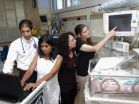Using an innovative combination of music psychology and leading-edge audio engineering the project is looking in more detail than ever before at how music conveys emotion.
The project, at Glasgow Caledonian University is supported by the Engineering and Physical Sciences Research Council (EPSRC).
The research could lead to advances in the use of music to help regulate a person's mood, and promote the development of music-based therapies to tackle conditions like depressive illnesses. It could help alleviate symptoms for people who are dealing with physical pain and even lead to doctors putting music on a prescription that is tailored to suit the needs of an individual.
"The impact of a piece of music on a person goes so much further than thinking that a fast tempo can lift a mood and a slow one can bring it down. Music expresses emotion as a result of many factors," says audio engineering specialist Dr Don Knox, project leader. "These include the tone, structure and other technical characteristics of a piece. Lyrics can have a big impact too. But so can purely subjective factors: where or when you first heard it, whether you associate it with happy or sad events and so on. Our project is the first step towards taking all of these considerations – and the way they interact with each other – on board."
Raymond MacDonald, Professor of Music Psychology at Glasgow Caledonian University, is also playing a central role in the initiative.
You can find out more about the research from the team involved on our Youtube channel.
The team has already carried out an unprecedentedly detailed audio analysis of pieces of music, identified as expressing a range of emotions by a panel of volunteers.
Each volunteer listens to pieces of previously unheard contemporary popular music* and assigns each one a position on a graph. One axis measures the type of feeling (positivity or negativity) that the piece communicates; the other measures the intensity or activity level of the music. The research team then assess the audio characteristics that the pieces falling into each part of the graph have in common.
"We look at parameters such as rhythm patterns, melodic range, musical intervals, length of phrases, musical pitch and so on," says Dr Knox. "For example, music falling into a positive category might have a regular rhythm, bright timbre and a fairly steady pitch contour over time. If tempo and loudness increase, for instance, this would place the piece in a more 'exuberant' or 'excited' region of the graph."
The team are now about to start their assessment of the impact of lyrics, and then hope to focus on how individuals use and experience music at a subjective level.
The ultimate aim is to develop a comprehensive mathematical model that explains music's ability to communicate different emotions. This could make it possible, within a few years, to develop computer programs which identify pieces of music that will influence a individual's mood (e.g. to motivate them when exercising or when revising for exams), meet their emotional needs and help them cope better with physical pain.
"By making it possible to search for music and organise collections according to emotional content, such programs could fundamentally change the way we interact with music," says Dr Knox. "Some online music stores already tag music according to whether a piece is 'happy' or 'sad'. Our project is refining this approach and giving it a firm scientific foundation, unlocking all kinds of possibilities and opportunities as a result".
INFORMATION:
Notes for Editors
'Emotion Classification in Contemporary Music' is a 3 year project due for completion at the end of October 2010. It is receiving EPSRC funding of just over £82,000.
* Music classified by the volunteers consists of contemporary popular music not available on general release, in order to eliminate any personal, subjective connotations any of the pieces may have for the volunteers. "This focus on popular music is an innovative feature of our project as previous studies on music's emotional content have concentrated on classical music," says Dr Knox. "We think concentrating on popular music is important as our work could have important implications for the use of personal music players and on how people interact with their music collections."
In this project, digital music files are analysed using advanced signal processing techniques. Many measures are based on extraction of the signal frequency spectrum over time. From this information, measures of intensity, timbre and rhythm can be calculated, in addition to estimates of musical pitch and tonality.
It is estimated that around 15% of people have a bout of severe depression at some time in their lives: http://www.nhs.uk/conditions/depression/Pages/Introduction.aspx
About EPSRC
EPSRC is the main UK government agency for funding research and training in engineering and the physical sciences, investing more than £850 million a year in a broad range of subjects – from mathematics to materials science, and from information technology to structural engineering. www.epsrc.ac.uk
Glasgow Caledonian University
One of the UK's most dynamic universities, Glasgow Caledonian offers a modern, cosmopolitan environment for learning, teaching and applied research.
Glasgow Caledonian University's mission is to provide a high quality, accessible, inclusive and flexible learning and teaching environment enhanced by curiosity driven research. It applies its knowledge and skills for the social and economic benefit of the communities it serves in Scotland and around the world. For more information visit: http://www.gcu.ac.uk/
For more information, contact:
Dr Don Knox, Glasgow Caledonian University, Tel: 0141 331 8436, D.Knox@gcal.ac.uk
Images are available from the EPSRC Press Office. Contact: EPSRC Press Office on 01793 444404, E-mail: pressoffice@epsrc.ac.uk
Image details and suggested captions:
Donald Knox 1 and 2. jpgs: Dr Donald Knox
Raymond MacDonald 1 and 2.jpgs: Professor Raymond MacDonald
Computer software.jpg: The computer software in action
Music Mixing 1 and 2.jpg: A studio mixing desk used in the research
Musician 1 and 2.jpg: The research is looking at how music conveys emotion
Live concert.jpg: People respond to music in different ways
END

